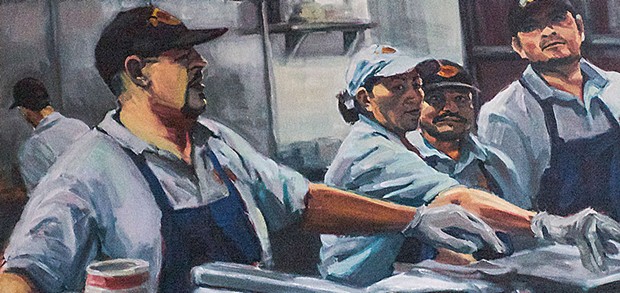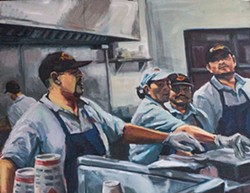[
{
"name": "Top Stories Video Pair",
"insertPoint": "7",
"component": "17087298",
"parentWrapperClass": "fdn-ads-inline-content-block",
"requiredCountToDisplay": "1"
}
]
There is a painting that hangs in my living room of three musicians. My husband bought it from a local painter. That painting bothers me a little. That's because the musicians are black and the artist is white. And we are white. Should that bother me? Clearly the artist appreciated musicians, as we do.
I thought about that painting when I attended a forum a few weeks ago at Humboldt State University over a different piece of art called "Super Taco."
It is a large painting of four middle-aged Latino workers in the kitchen of a fast food restaurant. The university hung it in the student cafeteria. That's when the trouble began. Many Latino students staff the cafeteria. Some of them, and some other Latino students who ate at the cafeteria, saw the painting as this message from the university to them: This is the most we expect you will achieve.
That was not the message artist Ryan Spaulding intended when he painted it. Spaulding was an HSU art student in 2013 when the painting won a juried art competition. As the university does each year, it bought the painting using a special President's Purchase Award for that purpose. The university had purchased a piece of student art each year since 1988. Spaulding painted the kitchen workers from a photograph he had taken when visiting a fast food place, one very much like the fast food places he had worked. His idea, according to the art department, was to paint people who are largely invisible in our society. He meant it as a tribute to the hard workers of the world. Spaulding is white.
The university responded to the protests over the painting by moving it to the library, where it hung on a wall around the corner from a row of paintings of white university presidents in suits. The juxtaposition only reinforced the message: White men become presidents, Latino students become low-paid workers.
Feelings about the painting were so strong that a forum to discuss it had to be moved because the room, which seats about 90, was too small. People couldn't get in.
I came out of the forum with a newfound realization of how widely a message can be interpreted. I was prepared to argue First Amendment — that to take down the painting was a violation of our free speech principles. But from the outset I found the First Amendment itself was up for interpretation. One student argued that we needed to dismiss First Amendment concerns because those in power used it to silence minority voices. The discussion moved on before anyone could respond — historically, at least, the First Amendment is the strongest protection minority voices have from suppression by those in power.
One woman said that we shouldn't look at this painting the same way we would one by the artist Diego Rivera. Again, the discussion moved on before anyone could point out that Rivera had left the United States after Nelson Rockefeller destroyed a mural of his before it was completed, because Rivera had painted in it Vladimir Lenin and a worker's May Day parade.
But one student pointed out that the First Amendment didn't apply in this case. No one had asked for the destruction of the painting or the money back from the painter. The issue, this student said, was who gets to decide what art gets hung up on the university's walls. If it were your living room, she asked, could the government come in and force you to hang a painting you did not like on your wall? The First Amendment was written to stop the government from prohibiting speech, not for protecting government-sponsored speech.
So the issue boiled down to this: Whose university is it?
If the president's office is the government and the students are the residents, should the government be able to dictate the art on the walls? Maybe the lesson the university should have taken from the forum — had President Rollin Richmond or Provost Bob Snyder attended it — was this: Maybe we should have a student art council to advise on art purchases and placements. Maybe the real issue was that Spaulding's painting stood out not because it was the only painting in the cafeteria, but because it was one of very few paintings on campus that featured Latino people in them. If the university, which has a rapidly increasing Latino student population, had Latino-themed paintings hung throughout campus, perhaps this one painting wouldn't have attracted so much hostility.
But maybe the painting did what it was supposed to do. It made people consider the image of hardworking people in low wage jobs and many found it disturbing. Art is not meant to be pleasant. If you want pleasant, you hang up a Thomas Kincaid. Art should provoke thought and pleasant does not do that.
So do I ask that the painting in my living room be taken down, even though I wasn't part of the decision to buy it or hang it there? It forces me to think about things I don't necessarily want to think about; when a white person paints black people, is it appreciation and respect or exploitation? If I appreciate the painting for its beauty do I endorse that exploitation?
Last year, we took our 7-year-old daughter to a ballet in San Francisco about the dancer and choreographer Vaslav Njinsky, which had themes of eroticism and homosexuality and was difficult to understand. The tickets came as part of a package with Cinderella. Afterwards I asked her to describe the ballet. She said: "That was art." She knows that when she sees something someone created that she doesn't understand, it's probably art. And she has learned to appreciate it for the artist's brave attempt to create something important, even though audiences might not like it.
Ryan Spaulding painted a picture of people largely invisible in our society. And in doing so, he made us focus on how much we depend on a group of people to serve us food for wages too low for them to feed their own families. And that is not a pretty picture.
Marcy Burstiner is chair of the Department of Journalism and Mass Communication at Humboldt State University.
Comments (7)
Showing 1-7 of 7
more from the author
-
Endangered
Why local news is a threatened species and what you can do to protect it
- Oct 3, 2019
-
Sinclairly Yours
- Jun 7, 2018
-
The General Concerns
- Nov 2, 2017
- More »

































